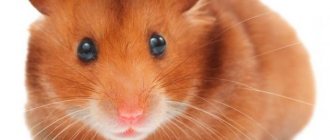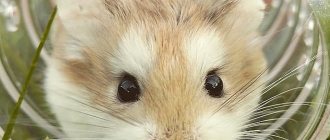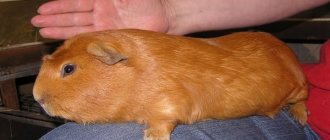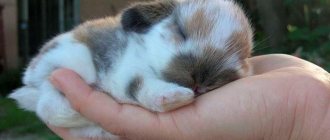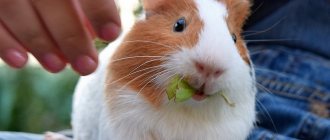What is the reason for such great popularity of these small animals as pets? Firstly, Djungarian hamsters are easy to care for and maintain. Secondly, they adapt perfectly to living conditions in an apartment, that is, they are easily tamed. As a result, you only need to follow a couple of simple rules to ensure that these unpretentious pets feel great in your home.
Description
Appearance
So, Djungarians, just like Syrian hamsters, are cute, very small animals; The hamster skeleton is only 9 - 12 centimeters in length. They usually weigh 40-65 grams. Their fur is short but thick, distributed evenly throughout the body.
Color
Most often, the fur on their back is gray or brown, and their belly is white. Small white spots are visible on the paws and in the inner area of the ears. In general, domestic hamsters are extremely diverse in terms of color, something their free relatives can no longer boast of. So, there are such unique species that have a cover of gray-blue or even delicate orange-cream shades. However, in winter they begin to shed and eventually the coat becomes more of a white color, except on the back, where the color is still grey.
Look at the photo below to see what a homemade dzhungarik looks like:
Character
Many people like that dzhungariks are very clean animals. They do not leave any specific or unpleasant odor behind. It is worth remembering that they are mainly active only at dusk, and prefer to sleep during the day or at night. This is not to say that these hamsters often show aggression, but sometimes they can still bite. Therefore, it is better not to leave a small child alone with the animal.
Lifespan
A big disappointment for the buyer can be the life expectancy of the Djungarian hamster. So, usually it is about 3 years. In fact, this is not so little for rodents. In wild conditions this period is even shorter. However, sometimes there are happy exceptions.
The history of the appearance of Djungarian hamsters in apartments
Djungarian hamsters (sometimes simply called Djungarians) are considered the most popular domestic breed of the hamster family. In the wild they are found in western Siberia, Dzungarian Alatau and Khakassia. Domesticated individuals differ slightly from wild hamsters in their coloring.
Hamsters began to be used as pets in the mid-20th century. At that time, Syrian hamsters were in great demand. They quickly gained popularity among people due to their unpretentiousness and easy care. The Dzungarian species of hamster was discovered in 1773.
Djungarians began to be bred for the first time in the USSR in the 50s of the last century. They were used for medical research.
At first, keeping them was problematic, as they were overly fearful and restless. Despite this, many hamsters from laboratories settled in the homes of zoologists. Later they fell into the hands of other animal lovers, thereby becoming pets. From Russia, Djungarian hamsters came to Europe and America.
Selection of dzhungarik
Determination of gender
Of course, you can ask the seller to check the gender of the animal, but sometimes they make mistakes. Therefore, it is better to make sure for yourself what gender the hamster is. So, to do this you need to lift the animal up with its belly. The female will have two closely spaced holes visible on the bottom. In the male, these two holes are located at a distance. In addition, the female has two rows of papillae running throughout the abdomen.
Number of pets
An example of a popular saying: “To make life more fun for rodents, it is better to buy a pair.” However, there is some disagreement on this issue. Many people believe that when buying two hamsters, it is better to keep them in separate cages. Otherwise, quarrels and fights between pets cannot be avoided, after which they receive various damages and injuries. Of course, there are exceptions when Djungarians coexist peacefully with each other, but they are rare. In general, it is better to think in advance about the number of animals you buy.
What to look for when purchasing
Choosing a jungarik is an important process, so you need to approach it responsibly.
Here are a couple of guidelines to help when buying a pet:
- To buy a rodent, you should choose a small pet store, as they pay more attention to the animals. And this directly affects the pet’s health and its life expectancy.
- It is necessary to pay attention to the age of the hamster, since they live only 3 years. The ideal option is to purchase a baby at the age of 6-10 weeks. Adults are larger and have yellowish teeth. The little hamster still has white teeth and ear hair.
- Determine the hamster's health status. Firstly, there should be no discharge from the eye or nose. Secondly, there are no signs of a fight or poor care - torn ears. Thirdly, there are no scratches or bald spots in the wool. Fourth, pay attention to the hamster's butt. If it is wet, then he has a fatal disease (“wet tail”).
- Also look at the behavior of the animal. If he doesn't mind being petted, then everything is fine. In addition to this, you can take it in your hands. It is advisable that it does not twitch in your hands.
The last important point is how much a Djungarian hamster costs. In a pet store, a hamster will cost about 300-500 rubles.
How to name
What to name your pet? In general, it is best to monitor his behavior. Thus, an eternally sleepy dwarf can deservedly bear the name Sonya, and an active one - Jumpy. Another source of inspiration is the color of the pet. For example, a hamster can be called Ryzhik or Snowball.
In general, the best option is to use your imagination or remember the names of characters from your favorite books or films. At least one of them will definitely suit your pet.
Differences between male and female Djungarian hamster
There are no external differences between hamsters of different sexes up to a certain age. A person who has not previously encountered hamsters and does not have the appropriate skills will most likely not be able to distinguish a female from a male if the rodent is less than 4 weeks old.
Determination by genitals is not a 100% way to determine sex, since the testes in newborn males are not fully developed (in both sexes, the genitals look like black dots). In an adult hamster they are almost always visible.
Hamster breeders use a visual examination to determine sex, which involves examining the distance between the anus and the genitals.
This method allows you to determine sex at the age of 20 days. In females, the distance between the anus and genitals is no more than 0.5 centimeters, and the male gland is not visible on the abdomen. In males, the distance exceeds these values and reaches 1.1 cm.
Preparing for content
External conditions
Hamsters' housing should not be located near noisy objects (for example, next to a TV) or radiators. It is not advisable for pets to get sunlight, so it is better to place the cage somewhere in the shade. The last condition is the absence of drafts. Otherwise, hamsters will get sick often.
Cage requirements
So, when choosing a cage for your Djungarian hamster, there are a few things to keep in mind. It should be spacious enough. The standard size is 30 by 50 centimeters. It is advisable to choose horizontal rods, since the pet will be able to crawl on them. Of course, we should not forget about the internal contents of the cell.
It is better to buy a house made of ceramic or wood, but they are expensive. It is believed that a plastic house is an ideal option both in terms of quality and price. It’s better not to choose a cardboard house, even though it costs the least. The hamster's home should be spacious, and the opening should be such that even with puffy cheeks the hamster could go inside.
Where to put the cage
The question often arises about where to put the cage. In this case, it is better to focus on external conditions. No sunlight, no drafts. In order not to disturb the rodents, it is better to place the cage away from sources of strong noise.
Possibility of keeping in an old aquarium
You should not keep hamsters in an aquarium. They don't like this: at the sight of human hands they begin to go crazy and rush at them. In addition, the aquarium creates an additional danger in the form that the air in it is poorly ventilated. As a result, bacteria begin to appear that are dangerous for dzhungariks.
Filler selection
Another important condition for the well-being of dzhungarika is bedding with the right filler.
Here's a short overview of popular options:
- Hay. A good option, as it is closest to natural conditions. In addition, the hamster will be able to make a nest out of it or even feast on it.
- Sawdust. Their main disadvantage is poor odor absorption. Nevertheless, this is one of the cheapest options, and the Djungarians themselves love to dig into it.
- Wood filler. The same sawdust, only pressed. However, it contains wood dust, which is dangerous for rodents. In addition, the filler is very large, it will be uncomfortable for the cubs to walk on it.
It is worth remembering that the choice of filler is no less important than the cells. And under no circumstances should you use cotton wool for this.
Feeder and drinker
In general, dzhungarikas do not like feeders, so they often turn them over with all their contents. Therefore, it is better not to place glass products, as there is a chance that they will break.
It is better to take an automatic drinker rather than a regular bowl. The second hamsters will quickly turn over.
Wheel, other toys, bath
An important component of any cage are toys. The wheel will help your dwarf hamster spend his extra energy somewhere. The pet store has a fairly large assortment of different tunnels, stairs, and the like for your pet. For the same purposes, you can add various branches or plant roots to the cage.
Under no circumstances should you wash the jungarik in water. You need to buy a special bathing suit and fill it with sand. It is there that the hamster will independently take all the actions he needs to clean his fur.
Filler
The cage must have a filler, which can be used as sawdust or shavings. They have the ability to absorb odor and water.
You can also use cellulose filler.
The corn filler retains odor and moisture well and is hypoallergenic. However, the hamster cannot dig in it and walking on solid particles can be uncomfortable.
It is strictly forbidden to use cotton wool, colored napkins, rags and newspapers, as well as sawdust or shavings from coniferous trees as bedding, as they can cause allergies in the hamster.
Features of care
Cleaning the cage
Cleaning the cage consists of the following simple steps:
- Replace the filler at least once a week.
- Clean the bottom of the cage once a month. You can even use laundry soap.
Taming
If on the first day in a new place the hamster behaves strangely and does not want to be handled, then you should not be afraid. This is a completely normal reaction, given that the dwarf is under stress right now. We need to give him time to get used to the new place and owners. Of course, you can speed up this process by offering the animal some kind of treat from your hand. In general, you shouldn’t pick it up quickly. You just need to take care of your dwarf hamster for a few days, and everything will be fine.
Games and entertainment
In addition to pet toys purchased at the pet store: wheels, ladders, tunnels, etc. – great entertainment for him is playing with the owners. In general, the dzhungarik quickly gets used to human hands, but also quickly loses the habit. So don’t forget about the little animal and give it your attention only once a week.
Appearance and character of the Djungarian hamster
A distinctive feature of these hamsters is the dark stripe on their back. Their size varies from 7 to 10 cm, and their weight ranges from 35 to 70 g. The fur is quite thick with white patches.
Djungarian hamsters have a calm character. They get along well with other hamsters. The period of greatest activity is late evening and night. Pets allow themselves to be held. Also, this type of hamster is characterized by high fertility and rapid maturation.
Feeding
Special feed
In general, it is best to feed dwarfs with specially formulated food, which is sold in most pet stores. However, it is worth paying attention to the composition of the products, as sometimes they contain ingredients that are completely unsuitable for hamsters.
Diet variety
Caring for dzhungarika is easy; A completely different situation is his nutrition. The diet of this animal is quite large.
Here are the foods he should eat regularly:
- vegetables and fruits;
- berries;
- cereals and grains;
- nuts, excluding almonds;
- homemade crackers.
Protein food
Another important part of a hamster's diet is protein. Several times a week they need to be fed low-fat cottage cheese, chicken (boiled) and boiled eggs. By the way, you must make sure that hamsters do not hide perishable foods in their pantries.
Mineral feeding
Djungarians love to chew mineral stone and grain sticks. This is not only useful, but also helps pets sharpen their teeth, which they grow throughout their lives.
Prohibited Products
Here is a list of some foods that are prohibited from feeding Djungarian hamsters:
- Various sweets: chocolate, ice cream, etc.
- Sausages, sausages.
- Potatoes, mushrooms.
- Fruit seeds.
- Citrus fruit
However, there is no need to worry about this. You can learn everything about feeding Djungarian hamsters at home from the seller at the pet store.
Watering
Djungarians need to be given water only. Instead of a standard bowl, it is better to buy a drinking bowl at a pet store, which can then be attached to the bars of the cage.
Accessories
Feeder
There should also be two feeders. One for dry food and one for fresh food. Ceramic ones are best, but plastic ones can be used as long as your hamster won't turn them over.
Drinking bowl
As a drinking bowl, you should use not a bowl, but a special automatic drinking bowl. Because the water in the bowl can quickly become dirty or the hamster can get wet and get sick.
House
It is advisable to place a small shelter in the cage, which replaces a mink in nature. There the pet will be able to hide, rest and store food supplies. Houses made from natural materials are best suited - wooden or cardboard, without a bottom.
It is not advisable to use plastic houses. In hot weather, you can place a ceramic house or a ceramic flower pot turned on its side.
Wheel
A wheel with a solid surface is required to maintain the physical shape of the hamster. The main thing is that the hamster’s back does not arch when running. Therefore, the diameter of the wheel must be at least 14 cm. In it, a hamster can run up to 15 km per day.
Breeding
Length of pregnancy
Djungarians are fertile animals. Females older than 4 months are capable of breeding. Their pregnancy lasts 3 weeks.
Caring for a pregnant female
Firstly, a pregnant female should be fed even more food. So, the diet should include granulated food and protein (boiled chicken, eggs, cottage cheese). Secondly, you need to prepare the room for future offspring in advance: disinfect all the contents of the cage.
Care of offspring
There is no need to feed the cubs: they drink mother's milk for 3 weeks. Under no circumstances should you pick them up, as the mother may smell someone else's scent on them and eat them.
Additional recommendations
Hamsters begin to age at 15 months of age. This is reflected in the deterioration of the health of their heart, respiratory and digestive systems, and teeth. To avoid a decline in quality of life, from this age more vitamins and mineral baits need to be introduced into the hamster’s diet.
Hamsters are nocturnal animals, so it is advisable to communicate with them closer to the dark - in the morning or evening. It is undesirable to disturb an animal during the day or disrupt its sleep pattern - this leads to aggression and health problems.
Taking care of your health
Signs of illness
There are quite a few symptoms indicating the onset of the disease in hamsters. These include aggression, and unmotivated aggression, ulcers on the body or baldness, apathy, breathing problems, loss of appetite and loose stools. If you observe one of the above symptoms, you should immediately contact your veterinarian.
Most common diseases
Among the most common diseases:
- Cold.
- Injuries (dislocations, fractures).
- Intestinal disorder.
- Conjunctivitis.
- Cataract.
Prevention
Many diseases are mainly caused by poor care. In addition to this, you should not constantly move the cage, change your pet’s daily routine, or introduce a new hamster. All this leads to stress, which is dangerous for the health of jungarians.
Diseases of Djungarian hamsters and treatment
In the wild, hamsters, like other rodents, are carriers of many diseases. However, pets purchased from a trusted store do not carry any infectious diseases.
Among the pathologies that domestic rodents may be susceptible to are:
1) a cold;
2) abscesses;
3) diabetes;
4) eczema.
An abscess in a hamster can occur after injury (for example, a strong blow to the cage or a fall). Diabetes develops due to poor diet and genetic predisposition. Eczema can be an allergic reaction to litter or a new toy.
Hamsters often experience problems with their teeth. If there is no special tooth sharpener in the cage, then the incisors grow too much.
This leads to malaise and refusal to eat. If a person notices that something is wrong with his pet, he should seek help from a veterinarian. It is extremely difficult to make a diagnosis and carry out treatment on your own.



